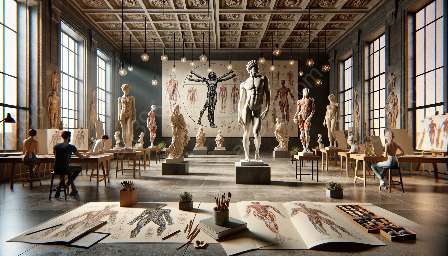Facial art is a captivating and intricate expression of human emotion and form. At the core of creating compelling facial art lies an understanding of lighting and shadow, in combination with a deep knowledge of facial anatomy for artists, and the principles of artistic anatomy.
The Significance of Lighting and Shadow in Facial Art
Lighting and shadow play a crucial role in accentuating the nuances and intricacies of the human face. As an artist, mastering the interplay of light and shadow on the face is essential for creating depth, realism, and emotional resonance in your work. Understanding how light interacts with the facial structures and how shadows fall across the features is fundamental to capturing the essence of a subject.
Relationship with Facial Anatomy for Artists
Facial anatomy for artists serves as the foundation for comprehending the structure and function of the human face. The knowledge of the underlying skeletal and muscular framework of the face provides artists with the ability to accurately depict facial expressions and characteristics with precision. When combined with an understanding of lighting and shadow, artists can elevate their art to new heights, creating lifelike and compelling portraits that resonate with viewers.
Understanding Artistic Anatomy
Artistic anatomy delves deeper into the study of the human form, encompassing not only the external features but also the underlying musculature and skeletal structure. By merging this comprehensive understanding with the principles of lighting and shadow, artists can imbue their facial art with a sense of dynamism and realism that transcends the canvas.
Techniques for Mastering Lighting and Shadow in Facial Art
- Observation: Take the time to observe how light interacts with the human face in various conditions. Notice the different types of shadows that form and how they accentuate or soften the features.
- Study of Facial Anatomy: Continuously expand your knowledge of facial anatomy for artists to understand how light and shadow interact with the complex structures of the face. Recognize how different facial features react to light and shadow, and how they contribute to conveying emotions.
- Experimentation: Embrace experimentation with different light sources and angles to understand their impact on the formation of shadows and highlights. This hands-on approach will deepen your understanding of the interplay between light and shadow in facial art.
- Value Control: Learn to control the values of light and dark to depict form and volume effectively. Understanding the concept of value is essential for creating convincing three-dimensional renderings of the face.
- Use of Color: Explore the role of color in depicting the interplay of light and shadow on the skin. Understand how warm and cool hues contribute to creating a sense of light and depth in facial art.
Conclusion
Lighting and shadow in facial art are not separate elements, but integral components that enrich the portrayal of the human face. When merged with a profound understanding of facial anatomy for artists and the principles of artistic anatomy, artists can breathe life into their creations, capturing the essence of their subjects with unparalleled depth and emotion.

